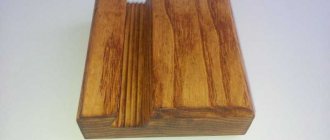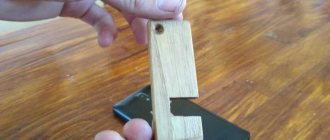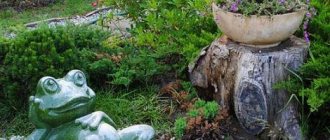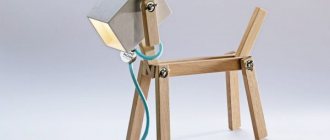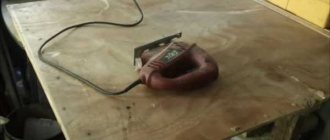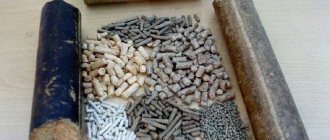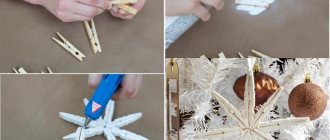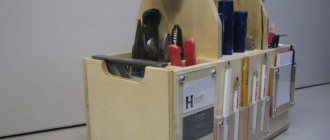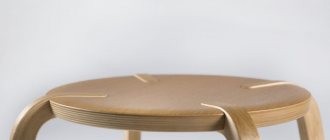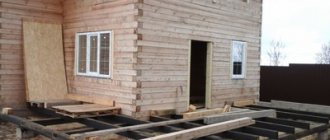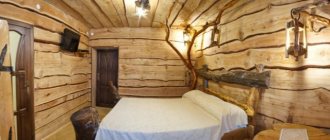Snags are partially rotten fragments of trees that have been lying on the ground for a long time.
Despite their unique and sometimes unpresentable appearance, driftwood is a good material for making various crafts and products.
The material combines fairly high mechanical strength and an unusual shape, and also has a wood texture.
In this article we will talk about what can be made from driftwood, and also teach you how to process this unique material.
How does such wood appear?
The basis for the appearance of snags is a living and dead tree, as well as its parts.
When a plant weakens or ages, its immune system can no longer effectively resist various pathogens and pests.
Therefore, damage appears in some areas, changing the properties of the wood.
Over time, damage leads first to death and then to decay of the wood, as a result of which part of the plant loses strength and is destroyed by wind, rain or other factors. Since there is no clear boundary between normal and damaged wood, the damaged areas take on the most bizarre shapes.
If destructive processes occur on a tree, then over time the damaged fragment breaks off from the trunk or roots and turns into a snag, that is, a severely damaged piece of any part of the tree.
If a branch or trunk breaks off from the tree even before the damage, then it will become a snag only after various microorganisms have sufficiently damaged it , and these defects will be noticeable even with a cursory examination.
If the damage affects the roots, then they turn into snags after the trunk breaks off from them, and the root system comes out of the ground under the influence of various factors.
Made of wood
A wooden chandelier will suit a kitchen in an oriental or country style. It is not suitable for a small room.
- The simplest option is bars knocked into the shape of a cross into which “fish eyes” are inserted.
- A wooden wheel from grandma's old spinning wheel can also be used to create a beautiful chandelier. It will become the basis on which the matte shades are fixed.
- An interesting design solution would be a chandelier made from small branches. To create it you will need a beach ball. It is pumped up and wrapped in cling film. Next, small tree branches in the shape of the letter “U” are glued onto this frame, the length of which is no more than 12 cm, and the thickness is 0.5 cm. The branches are used dry.
To ensure that the frame does not fall apart and is reliable, the branches are glued at 3-4 points. The result of the work is a spherical structure made of branches. If desired, the branches can be painted.
- Another option is to use branches of different lengths that cascade down from a round frame. The shape of this lampshade resembles a medieval chandelier and looks unusual.
- To create a spectacular chandelier on several floors, wooden clothespins are suitable.
Where can I find it and can I collect it?
Since driftwood comes from unmaintained trees, it is easier to find it in :
- forests;
- forest parks;
- forest belts;
- groves.
Despite the fact that Article 32 of the Forest Code of the Russian Federation allows the collection of snags and other fragments of trees separated from the plant in a natural way, local authorities often introduce various restrictions.
Therefore, before you go into the forest for snags, ask the local administration if there are any prohibitions at the local level.
After all, the federal law “On the general principles of organizing local self-government in the Russian Federation” dated October 6, 2003 N 131-FZ gives the local administration the right to independently establish the procedure for collecting any forest resources.
What to take as a basis
The central place in the design of any chandelier is the base. It is made from different materials and can be:
- wire;
- plastic;
- wooden;
- metal.
Often, the structural part of an old chandelier is taken as a basis, onto which new shades and decorative details are later attached. You can weave a wire frame yourself or use ready-made natural materials. Chandeliers whose structural basis is made from driftwood or massive branches look original in the kitchen interior.
In country houses and apartments decorated in chalet style, you can find chandeliers made from deer or elk antlers.
Preparation and processing
Here are the main ways to process this material:
- cleaning from dirt;
- cleaning of bark;
- drying;
- removal of loose wood;
- changing the shape of hardwood;
- putty;
- grinding;
- burning;
- impregnation with various reagents;
- painting and varnishing;
- polishing;
- connection with other parts.
Cleaning from dirt
To clean dirt, several methods are used, which differ in their effect on wood.
The simplest is washing - for this, the material is placed in a basin or bathtub and first watered with water to soften the dirt, then washed with a sponge.
If the surface of the wood is covered with something greasy, then you can use :
- any dishwashing detergent;
- washing powder;
- laundry soap crushed using a grater (toilet soap is less effective).
The advantage of this method is that it preserves the bark as much , but the disadvantage is its low efficiency, because it is impossible to remove dirt located in cracks and small depressions with a sponge.
A more effective way to clean the surface is to use a soft metal brush with brass or other soft metal bristles.
The brush removes dirt well and cleans even cracks and depressions, but it damages the surface of the wood, so it will have to be sanded. The most effective , but almost completely removing the bark, is to treat the driftwood with a high-pressure washer . This device removes any dirt, but does not damage the wood.
Cleaning the bark
Clearing bark can be either a separate operation or one of the actions carried out when removing loose wood or sanding.
In the first case blunt chisels are used to separate the bark from the wood. It is undesirable to use sharp chisels, because they can damage the wood and deprive it of its natural texture.
In the second and third cases, standard tools are used for removal or grinding, that is, attachments for a drill/grinder or sandblaster.
Drying
Forest snags have very high humidity (25–55%), which makes it difficult to stop the destruction processes in them, because high humidity is the main condition for the active life of microorganisms that feed on wood.
In addition, washing the material with a sponge or pressure washer further increases this parameter, making the material even more vulnerable. it is advisable to dry the driftwood after cleaning . This can be done by two methods - forced and natural.
For forced drying, the wood is placed in a dryer or oven and the heat is turned on.
The liquid inside begins to evaporate and seek a way out, which leads to cracking of the material. Depending on humidity and temperature, such drying takes 10–50 hours .
To dry naturally, the driftwood is placed in a well-ventilated, shaded room without drafts; it is advisable that the temperature in it be within 15–25 degrees above zero. Drying time is 10–30 months ; due to the slow release of moisture, new cracks do not appear on the surface of the wood.
Removing the loose part
Before removing loose or rotten wood, you must mark its boundaries with a simple pencil.
It is undesirable to use a marker for this purpose , because its paint is absorbed into the wood and can only be removed together with the top layer of the driftwood surface.
Then the middle of the rotten area is removed in various ways , for example:
- broken out by hand;
- knocked out with a hammer or an ax;
- cut with a jigsaw;
- grind off with a brush attachment with hard steel hairs.
During this stage, it is advisable to stay away from the edges of the hardwood, as you may accidentally damage them and then have to sand the area heavily. The debris at the border with hard wood is removed using a large rasp or a brush attachment with soft metal hairs.
Changing shape
Despite the fact that the unusual shape of the driftwood is its main advantage, sometimes the shape has to be changed .
For this:
- it is cut with a hacksaw, jigsaw or chainsaw, depending on the size and thickness of the snag;
- the surface of the material is leveled using manual/electric planes and jointers;
- Cutouts are made in the walls using manual and electric jigsaws.
All these operations are performed in the same way as when processing any other wood, for example, boards. Therefore, those who know at least a little how to work with wood will be able to independently change the shape of the driftwood, giving it the desired shape.
Putty
To seal cracks, both ready-made wood putties and a mixture of wood dust and PVA glue are used. You can get the dust of the desired color using a sander. In addition, you can use wood dust of any color and suitable water-soluble colors.
Before filling, it is necessary to clean the surface of the wood as much as possible and, if possible, sandblast it.
After filling the defect with putty, it is necessary to remove all excess so that the putty area does not protrude relative to the surface of the wood. If the dimensions of the defective area of the driftwood exceed the values recommended for putty, then it is advisable to fill the defect several times, this will prevent the putty from cracking.
Grinding
Using sanding , minor irregularities are eliminated and the wood texture is made clearer.
Coarse sanding can be done using a sander and coarse sandpaper or a brush attachment with soft metal hairs inserted into a drill.
Medium grinding of hard rocks, as well as medium and final grinding of soft rocks, is carried out only by hand using sandpaper with numbers from 20 to 6, gradually reducing the grit. For finishing hardwood sanding, use 5-grit or 4-grit sandpaper.
If during rough or medium sanding it is not possible to remove the lint, which constantly rises after the sandpaper passes, then the surface of the wood needs to be wetted. With any grinding method, it is necessary to periodically change the direction of movement of the sandpaper to avoid the formation of deep marks.
Burning
This operation is used to change the color of the surface of sanded driftwood, because during heat treatment the wood darkens, and the stronger the heating, the darker it becomes. You can burn the entire surface of the driftwood, or only individual areas.
For firing, use a blowtorch or gas torch. Before firing, all flammable substances must be removed.
If, by firing, the surface is made a little darker than necessary, and then sanded again, you will get a very unusual pattern of wood texture, which will retain its shape, but will greatly change the color.
Impregnation with various reagents
This impregnation is carried out if the finished product is located in places with high humidity or high temperature.
For such processing use:
- antiseptics (protect against pathogenic bacteria);
- insecticides (protect against insect pests);
- hydrophobic or water-repellent (to protect against high humidity);
- flame retardants (for protection against high temperatures and open fire).
For such processing, it is advisable to use only high-quality ready-made compounds, and also act in accordance with the instructions that are pasted on the containers with the reagent.
In addition, driftwood is often boiled in soda or table salt , but both methods are applicable only for those products that will then be constantly in water, because soda and salt are very hygroscopic, so they draw moisture even from the air.
Painting and varnishing
For painting, use both paint from aerosol cans and any water-soluble, for example, acrylic dyes.
Before painting with water-based materials, it is necessary to “wet” sand the surface to completely remove the lint, otherwise, after contact with water, it will rise and the surface will have to be sanded first to remove the dye, then painted again.
also use paints and enamels on any polymer base , but before doing this, the driftwood product must be thoroughly dried, otherwise excess moisture will not be able to escape through the vapor-proof polymer layer, and the wood will begin to deteriorate.
Also, the color of the wood surface can be changed using stains . Their main advantage is that they penetrate 0.1–1 mm deep into the wood, so by carefully sanding individual areas you can change the color saturation.
In addition, the color saturation in individual areas can be adjusted by the amount of stain or by applying it in several layers.
For varnishing, you can use any varnishes that are compatible with dyes. Varnishes based on acrylic and wood resin allow water vapor to pass through, so the workpiece can not be dried too much. Varnishes based on other polymeric materials form a vapor-proof film, so they can only be coated with well-dried driftwood.
Polishing and joining with other parts
Lacquered surfaces can be polished using the same mastics that are used for polishing parquet or wooden floors. In addition, you can use any polish for lacquered furniture.
There are two conditions for high-quality polishing :
- use mastic or polish that is compatible with varnish;
- strictly follow the procedure described in the instructions for the polishing material.
Often, driftwood is the main element, but only an element of the whole composition, so it has to be combined with other details.
For this they use:
- glue;
- dowels;
- nails;
- locks;
- threaded elements;
- furniture corners.
Any of the joining methods is no different from the same action applied to any wooden parts, so you will find more detailed information on this issue here.
We work with electricity
After your decor has acquired its shape, you can tackle the most difficult part, namely, connecting the electricity. Wires sold in hardware stores usually come in three colors: brown, blue and yellow-green. The latter is intended for grounding. However, outlets usually rarely have room for it.
So if you are using a ground cord, you can simply wrap it with electrical tape and leave it. All that remains is to connect the brown and blue wires. The neutral wire should be connected to the screw sheath and the phase should be tied to the center pin in the center of the socket. This is necessary because when screwing and unscrewing the lamp, the hot wire must be connected to the screw shell. If you touch the lamp threads, you may receive an electric shock.
Malakhov refused his Moscow registration and registered in the city of Apatity
Fashionable pastel: spring nail art that is easy to do yourself
We clean wooden floors and furniture from oil stains: use home remedies
What products can be made?
Due to their unique appearance and fairly high strength, driftwood is a good basis for making a wide variety of crafts.
Here's
a short list of what you can do with them:
- decorations for an aquarium or terrarium;
- lamps and chandeliers;
- candlesticks;
- decorative figures from driftwood for the garden and interior;
- furniture;
- wall and table decorations;
- watches and watch stands;
- gazebos.
Decorations for aquarium and terrarium
Driftwood in aquariums and terrariums not only play the role of decoration, but also create a more familiar habitat for fish and other living creatures.
You can choose any type of wood for your terrarium, but when making driftwood for your aquarium, it is best to use the hardest hardwood available.
Although you can use driftwood from branches, material from roots is better suited for terrariums and aquariums. Moreover, it is advisable to take driftwood for this purpose , that is, wood that has lain for a long time in the sea or running water.
The selected material must be cleaned of bark and dirt, then thoroughly treated with a sandblaster or a soft wire brush. This will help you find any rotten or moldy areas that need to be removed, including some of the healthy wood.
Since the use of purchased antiseptics is unacceptable, because they can be harmful to the inhabitants of terrariums and aquariums, during preparation the wood
is boiled in a solution of table salt for 3-10 hours .
After this, it is boiled for another 5–15 hours in clean water, changing the liquid every half hour.
This preparation completely cleans the wood of harmful substances and dangerous microorganisms, and also saturates it with water, so that it will not float.
If the snag still floats, then you can attach a rubber suction cup and use it to fix it at the bottom. If the driftwood is prepared for a terrarium, then after boiling it is dried in a ventilated room for 3–5 months.
Lamps and chandeliers
Due to their unusual shape, driftwood is well suited for making lamps and chandeliers. It is best to use driftwood from the butt (the lower part of the trunk) or roots, in which there is a depression with uneven edges .
You can install a lamp in the recess, and uneven edges, especially with roots coming out of them, will give bizarre shadows.
Making a lamp from driftwood usually includes several steps :
- cleaning from dirt and bark;
- removal of loose areas;
- drilling holes for hanging on a wall, ceiling or other surface;
- drilling holes for installing the lamp and socket;
- coarse and medium sanding with lint removal;
- impregnation with stains or firing;
- fine grinding;
- varnishing;
- polishing;
- installation of the lamp and socket;
- laying wires;
- wall mounting.
Candlesticks
To make a candlestick, driftwood of any shape is suitable, and the type of wood does not matter.
If the candlestick will stand on the table, then it is necessary to ensure maximum stability , which may require changing its shape.
If the candlestick will be installed on a wall or ceiling, then it is necessary to install the mount on the most durable part of the material.
The most important processing steps are:
- cleaning from dirt;
- removal of loose areas;
- grinding;
- impregnation with fire retardants.
In addition, it is very important to choose the right places and method of installing candles . Candles can be placed either directly into the wood, for which you need to drill a hole 1 cm deep in the driftwood, the diameter of which is slightly less than or equal to the diameter of the candle, or in metal glasses of any shape, which are attached to the wood using self-tapping screws.
Decorative items
In the vast majority of cases, when making decorative figures, all processing operations have to be performed, some of which need to be done several times.
Some driftwood are shaped like people, animals or mythical creatures , so they can be made into beautiful decorative figures and used in garden design.
Often you have to make a composition either from several driftwood, or from driftwood and various additional elements , which can be anything.
For example, a figurine of a mythical gnome can be decorated with a wide-brimmed hat and old boots. And a horse figurine - with tufts of natural or artificial hair imitating a mane and tail. In addition, you can make other garden crafts from driftwood, for example, flower stands
Beds, tables, cabinets and other furniture
To make furniture, it is necessary to use the strongest and largest driftwood from roots and branches, because the finished product will experience significant loads.
From this material you can make:
- tables and coffee tables;
- chairs or stools;
- beds;
- bedside tables and cabinets.
When making tables, only the legs or body are made from driftwood, and the tabletop has to be made from a different material.
The choice of finishing method depends on the shape and color of the driftwood, so in each case it is selected individually.
However, in any case, the required steps will be :
- cleaning from dirt;
- bark removal;
- sanding with lint removal;
- drying.
When making chairs or stools, both individual legs and the entire structure are made from driftwood.
To make such a chair or stool more comfortable, a soft bedding is made for it , which can either be attached to the surface of the seat, making it part of the structure, or made in the form of a removable pillow.
The minimum set of operations is the same as for tables. When making beds, driftwood is used as a decorative element or supporting structure.
In the first case, these can be relatively small parts of any thickness; in the second case, it is necessary to use only material from roots or thick trunks, and most of it must retain its mechanical properties .
The frame and lattice for the mattress are made of planed boards or metal, connected to driftwood in various ways to ensure the required strength and beautiful appearance.
In addition to the minimal processing used in the manufacture of other furniture, interior parts made from knots, branches, roots and snags must be thoroughly impregnated with antiseptics and insecticides so that various diseases do not appear in them and bugs do not settle in them.
All parts made of natural material must be varnished in order to prevent the raising of pile and the appearance of splinters.
For bedside tables and cabinets, only the body is made from driftwood , as can be seen in the photo, and the drawers and the top cover or tabletop of the piece of furniture (if provided for by the design) are made from other materials.
This approach allows you to make a bedside table that can not only be used to store things inside, but can also be used as a stand.
In addition to the minimum set of operations, you will have to change the shape of the driftwood, because without this it will not be possible to cut a box into it or attach a beautiful lid/tabletop on top.
Wall and table decor
Thanks to their unusual shape, driftwood makes stylish wall and table decorations . These can be flat, partially or completely three-dimensional figures. To make a flat decoration, you can use either a driftwood curved in two changes, or a cut from a large piece of driftwood of any shape.
The cut can be made with a chainsaw, circular saw or band saw, then level the surface with an electric plane or jointer. The same trimming can be done for a partially voluminous product; this will preserve the voluminous appearance, but will greatly reduce the overall thickness of the product.
On such decorations, the remains of bark can harmoniously fit into the overall design, so it is very important to remove as much as possible all damaged fragments and thoroughly saturate the workpiece with antiseptics and insecticides.
If such treatment is not done or done carelessly, then there is a high probability that in a few years, due to the destruction of cellulose, the bark will peel off from the wood, and it will have to be glued in place. In addition, various bugs can settle in poorly treated bark, which will ruin its appearance.
Watches and stands for them
Driftwood makes beautiful and stylish watch cases and stands.
To make the case, select driftwood, the size of which is noticeably larger than the size of the watch, then either insert it into a natural recess in the wood, or first cut or gouge out a hole for the watch with a chisel, then insert it there.
The first method is preferable for those who are not very good at working with a chisel, but the second method allows you to make a complete imitation of the fact that the watch is part of a piece of driftwood.
In addition, not only the case, but also the dial , into which the watch mechanism will then be embedded. To do this, you will need to not only create a flat plane, but also partially disassemble the clock, then attach the mechanism to the inside of the structure, and install the hands and numbers on the outside.
If a stand is made from driftwood, then it is necessary to select a material in the upper part of which there is a flat platform , not inferior in size to a watch.
In cases where there is no such platform, it can be made either by cutting off the top part of the material or by hollowing out a recess of the required shape in it using a chisel.
Gazebos
Thanks to their unusual shape, driftwood can be used to create decorative gazebos, including antique ones. The thickest and most durable driftwood is well suited for the role of load-bearing pillars ; medium and small sized pieces can be used for wall cladding.
Such a gazebo will look most stylish if its roof is made from tree bark or straw from various plants, while
the roof frame is best made from thin boards.
Chairs or benches, as well as tables in such a gazebo should also be made from driftwood, in which case the entire structure will be made in the same style.
To ensure that the wood does not lose its color over time, it is advisable not only to clean it , sand it and impregnate it with stain, but also to varnish it .
How to make a chandelier with your own hands from thread tassels and hoops
CBC Life YouTube channel
What do you need
- Yarn;
- small photo frame;
- scissors;
- 3 sets of wooden hoops of different diameters;
- 3 identical short and 1 long metal chains;
- pliers;
- bulb;
- lamp pendant.
How to do
1. Wrap the yarn around the photo frame many times and cut. Take a small piece of thread and tie it on top of the yarn so that the ends remain. Cut the threads on one side, where the frame hole is located.
CBC Life YouTube channel
2. Remove the yarn from the frame and fold it in half. Place the knotted thread in the middle so that its ends are at the bottom and the loop is at the top. Details are in the video below. Cut another piece of thread and use it to tie a tassel just below the loop.
CBC Life YouTube channel
3. Make the rest of the tassels in the same way. The quantity depends on the diameter of the hoop. The threads should frame them tightly.
CBC Life YouTube channel
4. Remove the center hoops from all hoops - you won't need them. Open the large hoop and put some of the tassels on them by the loops.
CBC Life YouTube channel
5. Close the large hoop. Place the tassels on the rest in the same way.
CBC Life YouTube channel
6. Make nine pieces of thread. Place the middle hoop into the large one and tie them in three places at the same distance from each other.
CBC Life YouTube channel
7. Place a small hoop inside and tie it to the middle one in three places. These threads should be located approximately in the middle between those that connect the large and medium ones.
CBC Life YouTube channel
8. Turn the design over and straighten the tassels. Tie short chains to a large hoop at equal distances from each other.
CBC Life YouTube channel
9. Use pliers to open the end link of the long chain. Place the attached chains on it and close it.
CBC Life YouTube channel
10. Attach the pendant to the ceiling, screw in the light bulb and thread the lampshade through the bottom. A long chain can be hung, for example, on a hook mounted on the ceiling next to the base of the chandelier.
What other options are there?
There is another way to mount a chandelier. Place a metal ring on the lamp hanger and attach chains tied to the hoop to it. The detailed process is shown in the video below. By the way, the technology for making brushes in it is slightly different. And the author does not use a hoop, but metal hoops.
The tips of the brushes can be painted in a contrasting color:
Or make a gradient chandelier from colored threads, like here:
Links to thematic forums
Homemade items made from driftwood are in great demand, so authors often discuss their works on thematic forums and share their experience there on what and how to do.
We have prepared a list of the most authoritative forums where you can get a lot of useful information:
- Forumhouse;
- Aquaforum;
- International Aquarium Forum;
- Farm "Nut Orchard";
- Forum about repair and construction;
- Club of decorative gardening lovers;
- Forum of aquarists of the Primorsky Territory.
Attaching the lamp socket
Using a drill and a drill, you need to create a hole in the branch for the cord. This must be done before connecting the outlet so that you can route the cord. If you don’t have a drill at hand, you can simply make a small groove using any sharp tool. Place the socket in the location where you intend to secure it. This should be done with the light bulb attached to see if it will actually stand up straight.
If you are satisfied with the appearance of the structure, proceed to process the selected surface with glue. To ensure that the hot melt adhesive adheres well to both surfaces, you need to let it heat up for at least 5 minutes.
Conclusion
Despite the fact that snags are partially rotted remains of trees, they are very well suited for making a wide variety of crafts. You can use them to make stylish decorations that will fit into any interior, as well as furniture and other items.
Any piece of driftwood, regardless of its shape and condition, can be used. However, in order for a product made from it to serve for many years, the material must be properly processed.
Now you know:
- what can be made from driftwood;
- how to prepare and process them;
- what kind of driftwood can be put in an aquarium, and where to look for other ideas and tips on the use of this material.
Crafting tools
Before you make an item such as a chandelier with your own hands, you should remember that a do-it-yourself chandelier requires certain costs. First you need to purchase a certain set of tools for woodworking. You will also need pliers, which are necessary when manipulating the wiring. Additional tools needed to make a chandelier include a hammer, screwdriver, measuring device (tape measure or ruler), drill, pencil and brushes.
To provide the tree with protection from the harmful effects of the environment, you should stock up on a special antiseptic. In addition, components from an old lighting fixture will come in handy. These include the base along with the base, lamps, wires, etc. To decorate a future chandelier, it is possible to use such items as various paper and woven elements, ropes, badges, etc. In principle, the list of materials and tools may differ from that described above , supplemented by other auxiliary items.
Material cleaning
Once you have found the right item, you will need to clean it thoroughly. Compressed air is best suited for this purpose. Use a special bottle with a long nozzle. It will more effectively remove dust and dirt from the branch. Of course, it’s unlikely that anyone has special equipment at hand at home. Therefore, to clean wood, it is quite possible to use ordinary pointed tools, for example, a chisel. You need to remove as much loose material as possible.
Finding a stable position
The next step in creating a driftwood lamp is to find a stable position. This is the most tricky and painstaking work. If your branch is long and thin, then you will need to balance it well so that it can take on a vertical position. It is unlikely that you will be able to do this perfectly on the first try. To balance the branch, use a sanding block. You will need to shape the driftwood so that it can stand upright without assistance. The branch should not swing or deviate in any position. The bottom edge rests entirely on a horizontal surface.
Interesting ideas
Almost any lamps can be made from wood: table, floor, pendant, wall. The simplest option for creating a table lamp:
- A small driftwood is sanded.
- A light bulb is screwed in on top, and the original product is ready.
Thick branches are also suitable for making lamps. Several blanks of the same length are made from them, the middle is drilled out and LED strips are inserted inside.
Driftwood chandelier
Using a piece of timber you can also build a miracle lamp for your table. The central part is cut out from the base, leaving the sides, and an LED strip is glued around the perimeter.
Advice! Such a lamp can stand either vertically or horizontally, or even be mounted on the wall instead of a painting or panel.
You can make a custom chandelier for the kitchen from an ordinary pallet. The base in it will, in fact, be a tray, and the light bulbs are screwed into glass jars hanging on cords.
If there is a small stump, a log remaining after uprooting or pruning trees, it is also suitable for making a tabletop lighting fixture. It will be possible to install as many light bulb sockets in it, as there are so many free barrels.
Any piece of driftwood can “transform” into a lamp – it will be convenient to mount it on the wall. If there are several blocks of unequal length, prepare a whole series of lamps, which are then attached to the board in a chaotic or orderly manner.
A creative table lamp made of bars, where LEDs are installed in the channels of the upper section, will add novelty to the desktop. The lamp parts are connected to each other by chops hidden inside. Round pendant lamps are made from branches glued together to form a ball.
Other unusual ideas for making wooden lighting fixtures:
- a vertical lamp made of thin bars, folded in the form of a log house with large gaps for light penetration;
- pendant chandelier made of round birch blanks inserted into each other through slots;
- a table lamp made of burnt bars or valuable wood, which are connected by a steel hinge;
- a long bar with built-in lamps, hanging on two chains or cords; it is ideal for lighting a bar, dining table, or work area in the kitchen;
- a lamp made of flat bars, folded into a pyramid or in any other way, equipped with miniature LED bulbs;
- coffee table made of sawn wood and glass with LED lighting.
Loft lamp made of timber to contents
